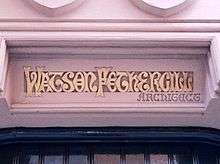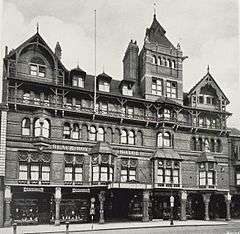Watson Fothergill
| Watson Fothergill | |
|---|---|
 Title above the door of the Watson Fothergill offices at 15 George Street, Nottingham | |
| Born |
July 12, 1841 Linden, Chesterfield Road, Mansfield |
| Died |
March 6, 1928 (aged 86) 7 Mapperley Road, Nottingham |
| Other names | Fothergill Watson |
| Occupation | Architect |
| Spouse(s) | Ann Hage |
| Practice | Associated architectural firm[s] |
| Buildings | Nottingham and Nottinghamshire Bank, Thurland Street, Nottingham |
Watson Fothergill (12 July 1841 – 6 March 1928) was an English architect who designed over 100 unique buildings in Nottingham in the East Midlands of England, his influences were mainly from the Gothic Revival and Old English vernacular architecture styles.
His work dates from 1864 (when he set himself up in practice) to around 1912. His earliest surviving known building dates from 1866.
Early life
Born Fothergill Watson in Mansfield, Nottinghamshire in 1841, he was the son of a wealthy Nottingham Lace merchant, Robert Watson and Mary Ann Fothergill. He changed his name to Watson Fothergill in 1892 to continue his maternal family name.
Family
He married Anne Hage in 1867[1] at St. John's Church, Mansfield.[2] His father-in-law was Samuel Hage,[1] one of the founding partners of Mansfield Brewery.
His half-brother was Robert Mackie Watson, chairman of the Mansfield Improvement Commission and the Brunts' Charity.
Career
In 1856, he entered the St Peter’s Gate office of Frederick Jackson, an architect and surveyor in Nottingham. In mid 1860 he moved as assistant to Isaac Charles Gilbert who was based in Clinton Street, Nottingham. After spending around 18 months with Gilbert, he moved in early 1862 to join the office of Arthur William Blomfield in London. In 1864 he was working with John Middleton in Cheltenham, but in the same year, left to set up his own office at 6 Clinton Street, Nottingham.[3] He remained at Clinton Street until it was demolished by the works in connection with the arrival of the Great Central Railway in 1894. He moved to a new temporary office at 18 George Street, and arranged to rebuild 15 George Street opposite which he completed the next year and moved in on 12 December 1895.
He is credited as having had a great impact on the architecture of the major British industrial city of Nottingham, and designed over a hundred buildings in the city, from offices, banks and warehouses, to churches and private dwelling houses. His easily recognisable style includes the use of contrasting horizontal bands of red and blue brick, dark timber eaves and balconies, and elaborate turrets and stone carving.
On his death in 1928, he left an estate valued at £73,908 5s 11d[4] (equivalent to £4,090,000 in 2016).[5]
List of major works[3]
All Nottinghamshire unless otherwise stated.
1860s
- Cemetery Chapels, High Street, Ongar (joint architect with Isaac Charles Gilbert) – 1866[6]
1870s
- Dwelling House, Mapperley Road, Nottingham (Fothergill's own house) – 1870
- Two Villas, 5 & 7 Lenton Road, The Park, Nottingham – 1873
- Temperance Hall (later Albert Hall), North Circus Street, Nottingham – 1873–1876
- Nottingham and Nottinghamshire Bank, Church Street, Mansfield – 1874–1875
- Nottingham Daily Express Offices, Printing Works and Shops, Parliament Street, Nottingham – 1875
- King's Arms, Ratcliffe Gate and Newgate Lane, Mansfield – 1875–1877
- Regency House, off Terrace Road, Mansfield - 1875
- Cattle Market, Nottingham Road, Mansfield – 1876–1878
- Congregational Church (later United Reformed), Westgate, Mansfield – 1876–1878[7]
- Nottingham and Nottinghamshire Bank and Residence, Thurland Street, Nottingham – 1877–1882[8]
1880s
- Villa, Crow Hill Drive, Mansfield – 1880
- Six Dwelling Houses, Shops and Carriage House, Castle Road and Houndsgate, Nottingham – 1882–1883
- Five Houses and Shops, Derby Road, Nottingham – 1884
- Institute and Coffee Tavern, High Street, Hucknall – 1884[9]
- Nottingham and Nottinghamshire Bank, Cattle Market, Loughborough, Leicestershire – 1885
- Villa, Loscoe Hill (Clawson Lodge), 405 Mansfield Road, Nottingham – 1885
- Institute and Coffee Tavern (Budworth Hall), High Street, Ongar, Epping Forest, Essex – 1885–1887[10]
- Villa (Walton House), 39 Newcastle Drive, The Park, Nottingham – 1886
- St. Nicholas' Church Rectory, Castle Gate, Nottingham – 1886–1887
- Pair of Villas, Loscoe Hill, 409 and 411 Mansfield Road, Nottingham – 1886–1887
- Nottingham and Nottinghamshire Bank, Kirk Gate, Newark on Trent (1885–1887)
- Rebuilding Black Boy Hotel (first major rebuild / extension), Long Row, Nottingham – 1886–1888
- Pair of Villas, 62 and 64 Castle Boulevard, Nottingham – C1888
- Pair of Villas, 3 and 4 Huntingdon Drive, Nottingham – C1888
- Samuel Smith & Co's Bank, 24 Market Place, Long Eaton, Derbyshire – 1889
- Warehouse (Milbie House), Pilcher Gate, Nottingham – 1889
1890s
- Villa, (Elberton House), Cavendish Hill, 9 Hardwick Road, Nottingham – 1890
- Eight Ladies' Homes – Norris Almhouses, Berridge Road, Nottingham – 1892–1893
- Emmanuel Church, Woodborough Road (1883–1893[11]) – demolished 1972
- Woodborough Road Baptist Church, Woodborough Road and Alfred Street North, Nottingham – 1893–1895
- Simons and Pickard Paper Warehouse, Lenton (Castle) Boulevard, Nottingham – 1893–1894
- House, Kingswood, Bulcote – 1893
- Two Semi-Detached Villas (Cleave House), 1 and 3 Sherwood Rise, Nottingham[12] – 1894–1895
- Rebuilding of Nos 15 & 17 George Street, Nottingham (Watson Fothergill's offices) – 1894–1895
- Jessops' Shop and Workrooms, 14–30 King Street, Nottingham – 1894–1897
- Four Shops and Offices (Queens Chambers), Long Row and King Street, Nottingham – 1896–1899
- Shop and Office (Furley and Co) (now Lloyds Bank), Parliament Street and Clinton Street, Nottingham – 1896–1897
- Ellenborough House, 3 South Road, The Park, Nottingham – extended 1896–1897
- Cuckson, Hazeldine and Manderfield Warehouses, Stoney Street and Barker Gate, Nottingham – 1897–1898
- Black Boy Hotel Additions and Two Shops (second major rebuild / extension), Long Row, Nottingham – 1897–1900
- Rebuilding of the Rose of England Inn, Mansfield Road, Nottingham – 1898–1900
- Brewery, Mar Hill, Carlton – 1899
- Nottingham and Nottinghamshire Bank and House, 111 Carrington Street, Nottingham – 1899
1900s
- Nottingham and Nottinghamshire Branch Bank, St Ann's Well Road, Nottingham – 1900–1901
- Sixteen Houses, Foxhall Road, Nottingham – 1901–1902
- Union of London and Smith's Bank, Market Place, Bulwell – 1904
- Villa, Mapperley Road, Nottingham (Joint Architect with Lawrence George Summers) – 1905
- Four Houses, Mansfield Road and Bingham Road, Nottingham – 1906–1907
Gallery
 Watson Fothergill's office at 15–17 George Street, Nottingham
Watson Fothergill's office at 15–17 George Street, Nottingham- Statue (by Nathaniel Hitch) on the frontage of Watson Fothergill's office
- Villa at Bridgegate in Retford
 Houses and Shops at Castle Road in Nottingham
Houses and Shops at Castle Road in Nottingham- Banking House at Kirkgate in Newark
- Eight Ladies Homes at Sherwood Rise in Nottingham
- Woodborough Road Baptist Chapel
 Queen’s Chambers at Long Row and King Street in Nottingham
Queen’s Chambers at Long Row and King Street in Nottingham Carlton Laundry
Carlton Laundry Castle Court, Castle Boulevard
Castle Court, Castle Boulevard Rose of England public house, Mansfield Road, Nottingham
Rose of England public house, Mansfield Road, Nottingham Black Boy Hotel, Long Row, Nottingham
Black Boy Hotel, Long Row, Nottingham
Further reading
- Brand, Ken (2009) "Watson Fothergill: a provincial goth", in: Ferry, Kathryn, ed. Powerhouses of Provincial Architecture, 1837–1914. London: Victorian Society; pp. 28–43
- Turner, Darren (2012) "A Catalogue of the Works of Watson Fothergill, Architect."
References
| Wikimedia Commons has media related to Watson Fothergill. |
- 1 2 "Marriages". London Evening Standard. England. 12 September 1867. Retrieved 4 March 2016 – via British Newspaper Archive. (Subscription required (help)).
- ↑ "Marriages". Nottinghamshire Guardian. England. 13 September 1867. Retrieved 4 March 2016 – via British Newspaper Archive. (Subscription required (help)).
- 1 2 Turner, Darren (2012). A Catalogue of the Works of Watson Fothergill, Architect. Nottingham: DT:P / Blurb.
- ↑ "Notts Architect". Sheffield Independent. England. 22 June 1928. Retrieved 6 March 2016 – via British Newspaper Archive. (Subscription required (help)).
- ↑ UK Retail Price Index inflation figures are based on data from Clark, Gregory (2017). "The Annual RPI and Average Earnings for Britain, 1209 to Present (New Series)". MeasuringWorth. Retrieved 6 November 2017.
- ↑ "Local and District News". Nottinghamshire Guardian. England. 12 January 1866. Retrieved 4 March 2016 – via British Newspaper Archive. (Subscription required (help)).
- ↑ "New Congregational Chapel at Mansfield". Nottinghamshire Guardian. England. 1 June 1877. Retrieved 4 March 2016 – via British Newspaper Archive. (Subscription required (help)).
- ↑ "The Notitngham and Notts Bank". Nottingham Evening Post. England. 21 March 1881. Retrieved 4 March 2016 – via British Newspaper Archive. (Subscription required (help)).
- ↑ "Hucknall Torkard". Nottinghamshire Guardian. England. 8 August 1884. Retrieved 4 March 2016 – via British Newspaper Archive. (Subscription required (help)).
- ↑ "Ongar. The Budworth Memorial Hall". Chelmsford Chronicle. England. 11 February 1887. Retrieved 4 March 2016 – via British Newspaper Archive. (Subscription required (help)).
- ↑ "Emmanuel Church, Nottingham. Consecration of New Chancel". Nottinghamshire Guardian. England. 18 March 1893. Retrieved 4 March 2016 – via British Newspaper Archive. (Subscription required (help)).
- ↑ "Sherwood Rise, Nottingham". Nottinghamshire Guardian. England. 12 November 1898. Retrieved 4 March 2016 – via British Newspaper Archive. (Subscription required (help)).
External links
- The Watson Fothergill Home Page
- A catalogue of Watson Fothergill's work
- Norris Ladies Almshouses, Berridge Road, Nottingham on Google Street View.
- Clawson Lodge, Watcombe Road, Nottingham on Google Street View
- 21 and 23 Newcastle Drive, The Park, Nottingham on Google Street View
- 39 Newcastle Drive, The Park, Nottingham on Google Street View
- Edale House, Clumber Road East, The Park, Nottingham on Google Street View
- No 3, South Road, The Park, Nottingham on Google Street View
- No. 5 and No. 7 Lenton Road, The Park, Nottingham on Google Street View
- No. 3 and No. 4 Huntingdon Drive, The Park, Nottingham on Google Street View
- 93–95 Derby Road, Nottingham on Google Street View
- The 'Buildings' section of Nottingham21 Web Site has photographs of most of the surviving Fothergill buildings in the city.
- A collection of photographs of Fothergill buildings on Geograph UK